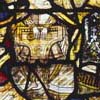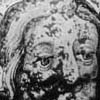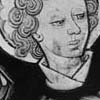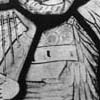Corpus Vitrearum Medii Aevi
Medieval Stained Glass in Great Britain
Your trail:
- CVMA Publications
- Norfolk: Cawston, Parish Church of St Agnes
Norfolk: Cawston, Parish Church of St Agnes
O.S. TG 133237
Chancel
North chancel chapel
nIV.
A1. A relieved estoile in the top foil on white
glass, set on a blue ground.
20
c.1450–60.
h 0.085m, w 0.07m
A2. As A1.
B1. A relieved estoile in the top foil on white
glass, set on a ruby ground. c.1450–60.
h 0.92m, w 0.07m
C1.
IHS monogram set on a glory in a quatrefoil
opening, in situ. Trace-line, relieving. White glass, with yellow
stain. c.1450–60. The bottom foil is missing and patched with
medieval fragments. Since 1970, two repair leads have been added.
h 0.225m, w 0.21m
D1. A fragment of micro-architecture, with the
base of a canopy shaft and chequered paving. Trace-line. White
glass, with yellow stain. c.1450–60.
h 0.135m, w 0.06m
D2. A fragment, possibly of a devil with hairy
skin and wings. Trace-line. White glass, with yellow stain.
c.1450–60.
h 0.135m, w 0.06m
UEA 35/13/14 (1970–75, b&w neg.)
David King (2007, digital colour photograph)
Nave
North aisle
nVIII.
H1–2. Eyelet filling consisting of a crocketted
arch. Trace-line. White glass, with yellow stain.
c.1420–30. Cracked, medium external corrosion.
h 0.285m, w 0.065m
UEA 35/13/12 (1970–75, b&w neg.)
David King (2007, digital colour
photograph)
nIX.
H1.
Eyelet filling with crocketted border
and quarry pattern. Trace-line. White glass, with yellow stain.
c.1420–30.
h 0.25m, w 0.04m
H2. Eyelet filled with fragments of
micro-architecture. Trace-line. White
glass, with yellow stain. c.1420–30.
h 0.25m, w 0.045m
UEA 35/13/9–10 (1970–75, b&w negs)
David King (2007, digital colour
photograph)
South aisle
sIX.
F1. An eyelet filling with vesica-shaped ornament in trace-line and
relieving. White glass, with yellow stain. c.1420–30. Some
external corrosion.
h 0.09m, w 0.055m
David King (2007, digital colour
photograph)
sX.
The main-light panels in this window are protected by a disfiguring external wire guard.
1a. Lower section. A standing musical angel with feathered tights playing a pig-snout psaltery, 21 feet turned to dexter, indicating that the angel faced in that direction; the head is an intruded fragment. The angel stands on a pedestal decorated with ears-of-barley pattern. Trace-line, matt wash. White glass, with and yellow stain. c.1450 – c.1460, except for the head, which may be earlier. To the right of the pedestal is part of a scroll on an ears-of-barley pedestal bearing in blackletter 'Blida', who was the mother of St Walstan. 22 To the right of the angel is part of a harp. To either side of the angel are fragments of ears-of-barley pedestal; part of an angel with a tunic and studded belt standing against a ruby ground; purple drapery; blue seaweed diaper; part of another pedestal with a foot; plants from the base of a panel; some elaborate canopy work; and part of a figure in a fur-trimmed tunic coloured olive-green and blue. All c.1450 – c.1460, except for the piece with plants, which could be c.1420 – c.1430.
Middle section. Top centre: a fine head of Christ with cruciform nimbus, facing to sinister; two small musical angels wearing white tunics, one facing to sinister and playing a Gothic harp, the other facing to dexter and playing a shawm. To the left: the lower half of a male figure in a blue, fur-trimmed tunic with orange hose, studded belt, purse, and dagger. To the right: part of a côte-hardie. Top right: part of a young male or female head facing to dexter. Other fragments include part of a mitre, blue cloud, and blue and purple drapery. c.1450–60, except for the two small angels and two heads, which are c.1420 – c.1430.
Top section. A nimbed and feathered musical
angel facing to dexter and playing a pig-snout
psaltery; trace-line; white glass with black paint and yellow
stain; c.1450 – c.1460. On the right, the lower part of a man
wearing a blue and blue-green party coloured tunic with
segmented belt and purple hose. He stands against a sea-weed
diaper with a curved edge. Top left: a glory emerging from a
cloud. Bottom left: a small figure of a bearded
prophet in a canopy niche. Other
fragments include part of a standing figure in a white robe with
yellow stain florette pattern; a hand holding a kerchief; green
drapery; wings; part of a glory; canopy work; and a few very
corroded pieces whose design is obscured. Prophet in the niche,
c.1420 – c. 1430; the rest, c.1450–60.
whole panel h 1.095m, w 0.43m
UEA 35/13/1, 35/13/2, 2V1A–6A (1970–75, b&w
negs)
David King (2007, digital colour
photograph)
1b. Lower section. Centre: a musical angel facing to sinister playing a small lute with a plectrum and wearing feathered tights; its head is a medieval replacement and the legs are missing; trace-line, matt wash; white glass with black paint and yellow stain; c.1450 – c.1460. To the left: another musical angel in feathered tights playing a small lute, this time plucked with the right hand and again with a replaced head; technique and date as the first angel. The rest of this section is made up of ruby, blue, amber, and purple drapery(?); blue seaweed diaper; blue cloud; wings; canopy; a fragment with plants; and some very corroded pieces, including an angel playing a ?flute from canopy shafting. One fragment on the right is inside-out. Corroded glass, c.1420 – c.1430; the rest, c.1450–60.
Middle section. Centre: the head and upper body of a young man or woman facing to sinister and wearing a white tunic; trace-line, matt wash; white glass, with black paint and yellow stain. To the left: part of the body of a male figure turned to sinister, wearing a fur-lined and fur-trimmed houppelande party coloured in blue-green and orange, with right armed raised across his chest; to the left of this is a fragment including part of what appears to be a trumpet. To the right: a standing eagle with wings spread, facing to sinister against micro-architecture, probably part of a canopy. Above the young person’s head: a dove flying from left to right, with cross nimbus, representing the Holy Spirit. On each side is a nimbed lamb on a pedestal, facing inwards, probably from the side shaft of a canopy. Between the dove and the lamb on the left is a left hand emerging from the sleeve of a fur-trimmed murrey sleeve, holding a cloth or kerchief. Bottom right is an almost opaque fragment depicting a prophet from a canopy shaft. The background to these pieces consists of fragments of ruby diaper and blue, green, and white glass. The central figure, the lambs, dove, and corroded pieces, c.1420 – c.1430; the rest, c.1450 – c.1460.
Top section. Centre: a fairly complete figure of a
musical angel facing to dexter,
playing a small lute with a plectrum and wearing feathered
tights and a segmented belt; technique and date as the two
angels in the bottom section; again the head is an intruded
piece. To the left: part of the body of a male
figure turned to sinister, wearing a fur-lined
and fur-trimmed houppelande, purple below the waist and blue on
the sleeve. The right arm points to the right. On the right side
of the purple tunic is a relieved glazier’s sorting mark, type
17. Part of another fur-lined and fur-trimmed houppelande in
green is on the right of the angel, also part of a portative
organ. Top right and left: two crocketted canopy arches. Top
centre: part of a yellow-stain glory descending from white
clouds. Other larger fragments include (on the right) a small
lute played by a hand with a plectrum, and a section of seaweed
diaper on white glass. The background is mainly pot blue, with
some white canopy fragments and purple drapery. c.1450 – c.1460.
whole panel h 1.1m, w 0.43m
UEA 35/13/1, 35/13/3, 2V/8A, 12A (1970–75, b&w
negs)
David King (2007, digital colour
photograph)
1c. Lower section. Centre: a musical angel playing a pig-snout psaltery and wearing feathered tights; trace-line; white glass with black paint and yellow stain; the head is a medieval intrusion. To the right: part of another musical angel playing a harp. To the left: part of a figure in a party-coloured ruby and purple fur-lined and fur-trimmed tunic; a piece of blue dagged drapery may belong to this figure. To the far left: two pieces of canopy shaft and two of seaweed diaper, one with an ornate staff set against it, perhaps part of a crozier or cross staff. To the right, a very worn fragment with a head and fur collar. Below: a section of a white tunic with belt; part of a pedestal with plants below; a large fragment of micro-architecture; part of another pedestal with ears-of-barley pattern and the tip of a wing; parts of a pair of wings; a piece of micro-architecture with seaweed diaper; and fragments of ruby and pot blue glass. All glass, c.1450 – c.1460.
Middle section. Left: part of a musical angel playing a lute and wearing feathered tights and a segmented belt, standing on an ears-of-barley pedestal; trace-line, matt wash; white glass, with black paint and yellow stain; c.1450 – c.1460; part of the original head survives. Next to it a piece with a hand holding what appears to be a pot, or a lamp, possibly part of a Wise Virgin. Top right: a piece with two heads, one male and bearded, the other female, both facing to sinister; trace-line, stippling, relieving; white glass, with black paint and yellow stain; c.1420 – c.1430. Next to it, an angel’s head and part of a white tunic with belt. Bottom left: a lute being plucked by a musical angel wearing ermine. In the centre: a small nimbed head facing to dexter. Bottom right: a harp being played by a hand and part of a wing, from a musical angel; above it, an eagle from a canopy. Otherwise, mainly fragments of ruby and pot-blue glass with seaweed diaper. There are also some pieces of almost opaque white glass depicting a head, perhaps of Christ, an angel facing to sinister, and another of a young person facing to the front. c.1450 – c.1460, except for the small angel’s head in the centre, the opaque pieces, and perhaps the hand with a pot or lamp.
Top section. Centre: a fairly complete nimbed musical
angel, playing a harp, facing to dexter and
wearing an ermine tippet and white tunic; trace-line, matt wash;
white glass, with black paint and yellow stain; the head has a
crack and repair leads, and the bottom part of the figure is
missing. To the right: some wings and a lute being played by two
hands, also part of a musical angel in
feathered tights playing a pig-snout psaltery; trace-line; white
glass, with black paint and yellow stain. To the left: several
pieces of canopy work. Above: part of a glory emerging from
cloud. All c.1450 – c.1460.
h 1.105m, w 0.43m
UEA 35/13/1, 35/13/4, 2V/13A–17A (1970–75, b&w
negs)
David King (2007, digital colour
photograph)
A1.
Foliage eyelet. Trace-line, relieving.
White glass, with black paint and yellow stain. c.1420 – c.1430.
Severe paint loss, three repair leads.
h 0.10m, w 0.09m
A2. As A1, with less paint loss and one repair lead. c.1420 – c.1430.
h 0.10m, w 0.09m
A3. As A1, with no repair leads. c.1420 – c.1430.
h 0.10m, w 0.09m
E1.
Foliage eyelet. Trace-line, relieving.
White glass, with black paint and yellow stain. c.1420 – c.1430.
Good condition.
h 0.06m, w 0.05m
E2. Unidentified fragment, with trace-line. White glass, with black
paint and yellow stain. 15th-c.
h 0.06m, w 0.05m
F1.
?Estoile set on fragments. Ruby glass
with relieving. c.1420 – c.1430. Some corrosion.
h 0.10m, w 0.10m
UEA 35/13/5 (1970–75, b&w neg.)
David King (2007, digital colour
photograph)
sXI.
E1–2.
Foliage eyelets, with trace-line. White
glass, with black paint and yellow stain. c.1420 – c.1430.
h 0.06m, w 0.05m
UEA 35/13/6 (1970–75, b&w neg.)
David King (2007, digital colour
photograph)
sXII.
B1–4.
Foliage tracery-light filling,
consisting of two pods, each with two serrated leaves.
Trace-line, thin matt wash. White glass, with black paint and
yellow stain. c.1420 – c.1430. B3 cracked and bodged, B4 with
small hole.
h 0.425m, w 0.11m
D1.
Trefoil, with central opaque boss and in
foils a crocketted vesica or half vesica. Trace-line, matt wash,
relieving. White glass, with black paint and yellow stain.
c.1420 – c.1430.
h 0.325m, w 0.145m
D2. As D1, with pot-blue boss, painted with flower. Trace-line. White
glass, with black paint and yellow stain. c.1420 – c.1430.
h 0.325m, w 0.145m
E1–2.
Eyelet filling, with crocketted vesica;
technique as D1. c.1420 – c.1430. Some paint loss on E1.
h 0.11m, w 0.055m
UEA 35/13/7 (1970–75, b&w neg.)
David King (2007, digital colour
photograph)
Footnotes
- 20.
- A photograph taken in 1970 shows these two estoiles in B1 and B2, and the one now in B1 in C1. Return to context
- 21.
- The identification of this and other musical instruments at Cawston is from Rose 2001, pp. 200–201. Return to context
- 22.
- James 1919, p. 239; Woodforde MS cited in Manuscript Sources, p. 17; Woodforde 1935a, p. 139. Return to context






